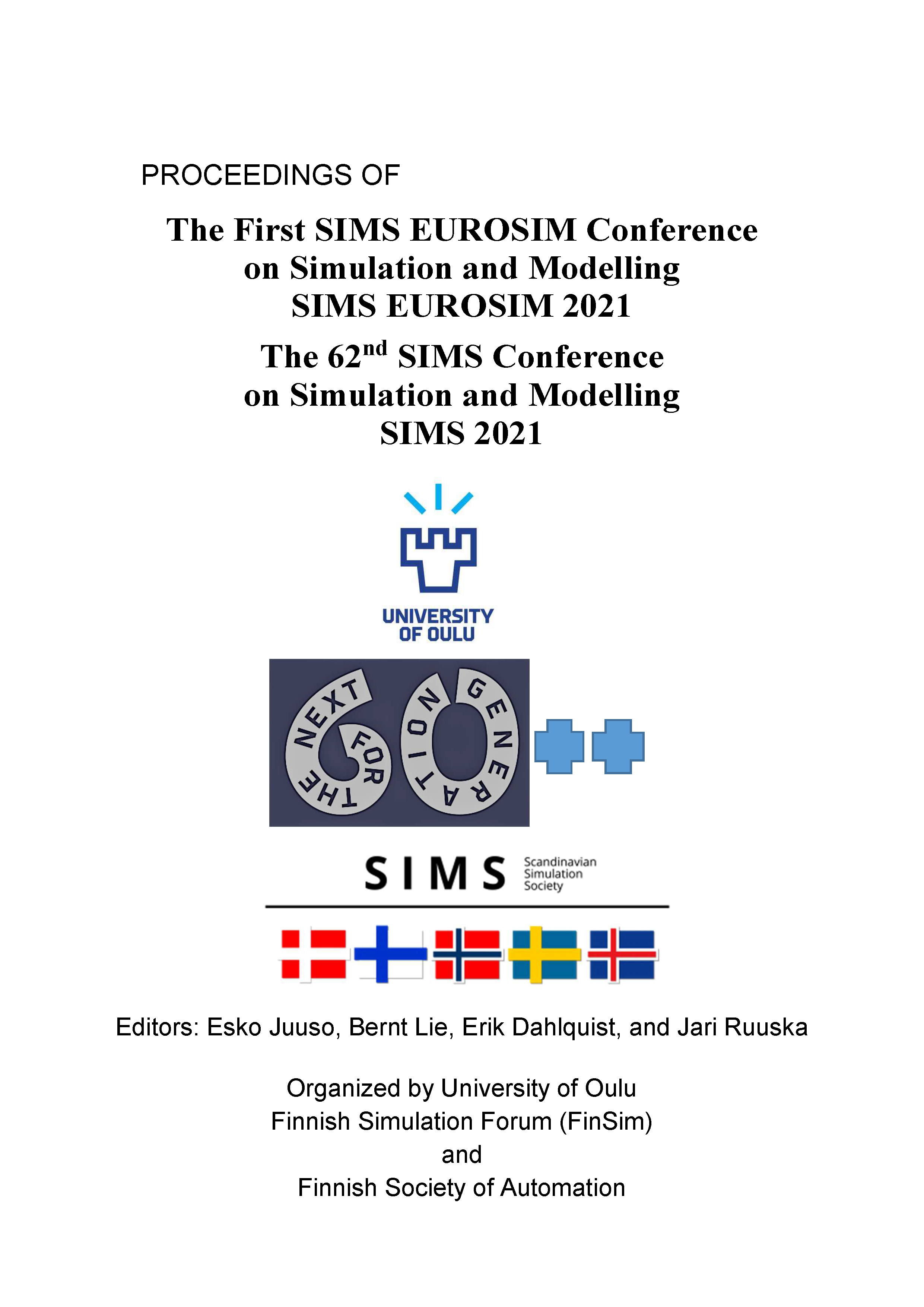Anaerobic Digestion of Aqueous Pyrolysis Liquid in ADM1
DOI:
https://doi.org/10.3384/ecp21185458Keywords:
anaerobic digestion, lignocellulosic biomass, aqueous pyrolysis liquid, phenol, furfural, HMF, inhibition, ADM1Abstract
Aqueous pyrolysis liquid (APL) is formed from pyrolysis of lignocellulosic biomass and is considered as a possible feed for anaerobic digestion (AD). APL is known to contain many components that can have a negative impact on the AD process. In this study, APL is fed into experimental AD batch reactors and modelled as a substrate using the Anaerobic Digestion Model No. 1 (ADM1), extended by addition of the inhibitors phenol, furfural, and 5-hydroxymethylfurfural (HMF). Simulation performed with the extended ADM1 has a better ability to predict the behavior of APL than the standard ADM1. Reducing the inhibition constants and startup concentration of active biomass during simulation of APL at high organic load resulted in improved fit with experimental results, but these inhibitors alone cannot explain the reduced methane production rate at high organic load.References
M. Badshah. Evaluation of process parameters and treatments of different raw materials for biogas production (PhD Thesis), Lund University, 2012. https://lup.lub.lu.se/record/3130472
D. J. Batstone, J. Keller, I. Angelidaki, S. V. Kalyuzhnyi, S. G. Pavlostathis, A. Rozzi, W. T. M. Sanders, H. Siegrist, and V. A. Vavilin. The IWA Anaerobic Digestion Model No 1 (ADM1). Water Science and Technology, 45(10), 65–73, 2002. https://doi.org/10.2166/wst.2002.0292
W. H. Bergland, C. Dinamarca, M. Toradzadegan, A. S. R. Nordgård, I. Bakke, and R. Bakke. High rate manure supernatant digestion. Water Research, 76, 1–9, 2015. https://doi.org/10.1016/j.watres.2015.02.051
D. J. Blum, and R. E. Speece. A database of chemical toxicity to environmental bacteria and its use in interspecies comparisons and correlations. 63(3), 198–207, 1991.
G. Brune, S. M. Schoberth, and H. Sahm. Growth of a Strictly Anaerobic Bacterium on Furfural (2-Furaldehyde). Applied and Environmental Microbiology, 46(5), 1187–1192, 1983. https://doi.org/10.1128/AEM.46.5.1187-1192.1983
M. S. Elshahed, V. K. Bhupathiraju, N. Q. Wofford, M. A. Nanny, and M. J. McInerney. Metabolism of Benzoate, Cyclohex-1-ene Carboxylate, and Cyclohexane
Carboxylate by “Syntrophus aciditrophicus” Strain SB in Syntrophic Association with H2-Using Microorganisms. Applied and Environmental Microbiology, 67(4), 1728–1738, 2001. https://doi.org/10.1128/AEM.67.4.1728-1738.2001
Q. Feng, and Y. Lin. Integrated processes of anaerobic digestion and pyrolysis for higher bioenergy recovery from lignocellulosic biomass: A brief review. Renewable and Sustainable Energy Reviews, 77, 1272–1287, 2017. https://doi.org/10.1016/j.rser.2017.03.022
B. Fezzani, and R. Ben Cheikh. Extension of the anaerobic digestion model No. 1 (ADM1) to include phenol compounds biodegradation processes for simulating the anaerobic co-digestion of olive mill wastes at mesophilic temperature. Journal of Hazardous Materials, 172(2–3), 1430–1438, 2009. https://doi.org/10.1016/j.jhazmat.2009.08.017
D. S. M. Ghasimi, K. Aboudi, M. de Kreuk, M. H. Zandvoort, and J. B. van Lier. Impact of lignocellulosic-waste intermediates on hydrolysis and methanogenesis under thermophilic and mesophilic conditions. Chemical Engineering Journal, 295, 181–191, 2016. https://doi.org/10.1016/j.cej.2016.03.045
N. Ghimire, R. Bakke, and W. H. Bergland. Thermophilic Methane Production from Hydrothermally PretreatedNorway Spruce (Picea abies). Applied Sciences, 10(14), 4989, 2020. https://doi.org/10.3390/app10144989
T. Hübner, and J. Mumme. Integration of pyrolysis and anaerobic digestion – Use of aqueous liquor from digestate pyrolysis for biogas production. Bioresource Technology, 183, 86–92, 2015. https://doi.org/10.1016/j.biortech.2015.02.037
Ionization Constants of Organic Acids. (n.d.). Retrieved April 21, 2021, from https://www2.chemistry.msu.edu/faculty/reusch/VirtTxtJml/acidity2.htm
B. Liu, V. A. Ngo, M. Terashima, and H. Yasui. Anaerobic treatment of hydrothermally solubilised sugarcane bagasse and its kinetic modelling. Bioresource Technology, 234, 253–263, 2017. https://doi.org/10.1016/j.biortech.2017.03.024
P. J. McNamara, J. D. Koch, Z. Liu, and D. H. Zitomer. Pyrolysis of Dried Wastewater Biosolids Can Be Energy Positive. Water Environment Research, 88(9), 804–810, 2016.
https://doi.org/10.2175/106143016X14609975747441 P. Olguin‐Lora, L. Puig‐Grajales, and E. Razo‐Flores. Inhibition of the acetoclastic methanogenic activity by phenol and alkyl phenols. Environmental Technology, 24(8), 999–1006, 2003. https://doi.org/10.1080/09593330309385638
S. Pang. Advances in thermochemical conversion of woody biomass to energy, fuels and chemicals. Biotechnology Advances, 37(4), 589–597, 2019. https://doi.org/10.1016/j.biotechadv.2018.11.004
S. Seyedi, K. Venkiteshwaran, and D. Zitomer. Toxicity of Various Pyrolysis Liquids From Biosolids on Methane Production Yield. Frontiers in Energy Research, 7, 5, 2019. https://doi.org/10.3389/fenrg.2019.00005
I. Sharma and G. A. Kaminski. Calculating pKa values for substituted phenols and hydration energies for other compounds with the first-order Fuzzy-Border continuum solvation model. Journal of Computational Chemistry, 33(30), 2388–2399. PubMed, 2012. https://doi.org/10.1002/jcc.23074
C. Torri, and D. Fabbri. Biochar enables anaerobic digestion of aqueous phase from intermediate pyrolysis of biomass. Bioresource Technology, 172, 335–341, 2014. https://doi.org/10.1016/j.biortech.2014.09.021
C. Wen, C. M. Moreira, L. Rehmann, and F. Berruti. Feasibility of anaerobic digestion as a treatment for the aqueous pyrolysis condensate (APC) of birch bark. Bioresource Technology, 307, 123199, 2020. https://doi.org/10.1016/j.biortech.2020.123199
X. Yu, C. Zhang, L. Qiu, Y. Yao, G. Sun, and X. Guo. Anaerobic digestion of swine manure using aqueous pyrolysis liquid as an additive. Renewable Energy, 147, 2484–2493, 2020. https://doi.org/10.1016/j.renene.2019.10.096
Y. Zhang, B. Han, and T. C. Ezeji. Biotransformation of furfural and 5-hydroxymethyl furfural (HMF) by Clostridium acetobutylicum ATCC 824 during butanol fermentation. New Biotechnology, 29(3), 345–351, 2012. https://doi.org/10.1016/j.nbt.2011.09.001
Downloads
Published
Issue
Section
License
Copyright (c) 2022 Dheeraj Raya, Nirmal Ghimire, Gudny Øyre Flatabø, Wenche Hennie Bergland

This work is licensed under a Creative Commons Attribution 4.0 International License.

